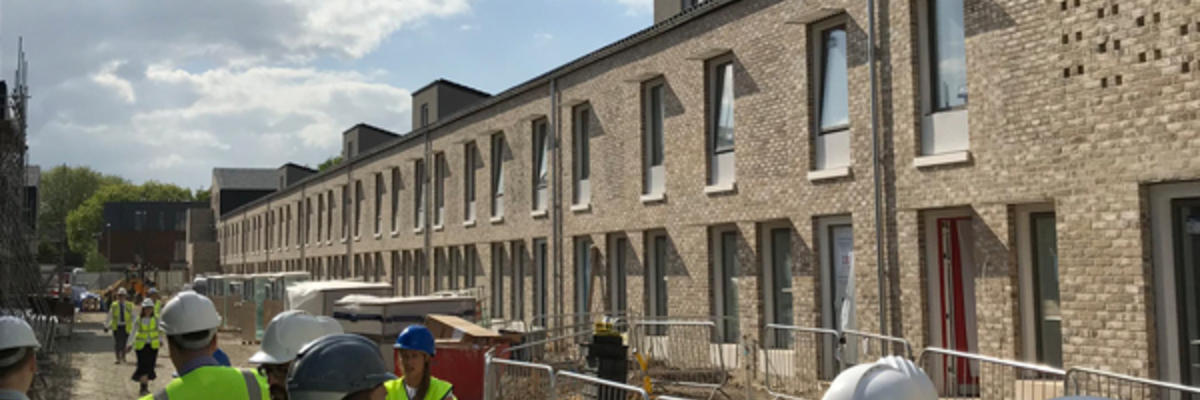Commentary
Dr Alice Owen
9 March 2020
The construction industry literally shapes the places where we live and work. Buildings do more than provide shelter, they create character and allow (or disable) activities. The construction industry also provides the shape of the infrastructure that tells us how to use a place – the roads, bridges, and canals that connect, or sever, people and places.
Construction is a big deal in the economy too. In 2018, the Office for National Statistics reported that more than 1.3 million people were employed in construction, in 325 000 firms. The vast majority, around 80% of those firms, are sole traders or micro-enterprises employing three people or less. Those are the official numbers; with the construction industry’s reputation for a considerable grey market dealing in "cash in hand", the actual number is likely to be much higher.
Construction also contributes a big element of the carbon emissions that are changing our climate. Using energy in building, particularly in heating buildings, is responsible for around one third of annual carbon emissions in the UK when the emissions associated with generating electricity for use in buildings is included. And, despite progress in decarbonising the electricity grid, energy demand in our homes remains stubbornly high, accounting for 18% of national carbon emissions. The UK’s Committee on Climate Change 2019 progress report showed us that emissions from buildings have increased by a small amount since 2015, even when adjusted for temperature.
While it’s important that we change the construction industry so that our new buildings and structures going forwards are zero carbon, somehow we’ve got to face up to this challenge: emissions are associated with the 23 million homes that we’ve already got. The structure of home ownership doesn’t help here. The social housing sector has been leading the way for years, with the most recent example of Goldsmith Street in Norwich receiving justified attention from architects as well as social policy makers, not least because reducing bills reduces the rate at which tenants default on rent. However, less than one in five UK homes are social housing.
Private landlords, providing another one in five homes, have no incentive to improve energy performance since they don’t pay the energy bills. Since 2018 there has been a minimum energy efficiency requirement for properties with new tenancy agreements, but this requirement, of energy performance level “E” is a long way off the level “A” which carbon reduction targets require.
The challenge for home owners
For all the other owner-occupiers, the decision to invest in your home to reduce energy bills in a dramatic way will rarely offer payback within the time you live in that building. Even if you are able to go ahead anyway, how do you get advice you can trust on what to do? And how do you find the tradespeople to do the work? This is not the kind of undertaking that the average homeowner in the UK has the time or motivation to tackle.
But there may be a ray of hope on the horizon for the homeowners with mortgages. Alerted, in part, by the Bank of England’s requirement that finance providers understand the climate impacts of their activity, mortgage lenders are becoming aware of the liability presented by energy demand of the homes that they are lending against. Nationwide, for example, has just announced a range of “green mortgages” to incentivise buyers to buy more energy efficient houses or retrofit older houses; a sign that perhaps mortgage lending and conditions can take away at least some of the financial barriers to transforming your home to a zero carbon home. There must also be opportunities in finance that’s available as some “first movement” developers seek to offset any unavoidable emissions associated with new construction projects. (As yet there is still no legal requirement for developers to do this.)
So there’s the first major challenge in achieving net zero in construction: doing retrofit at scale when there is no economic reward to do so, and when home improvements are done in a very fragmented way by tens of thousands of small building firms working for tens of thousands of clients each year.
Embedded carbon, carbon used during construction itself, is reducing, although as the energy efficiency of new homes improves, it is becoming proportionally more. New buildings, particularly new homes, could be built with virtually zero energy demand, with renewable energy generation from photovoltaic cells or heat pumps, and with energy storage systems for home energy and potentially electrical vehicle charging all connected. This will only happen if the construction “client” – a developer – wants it to happen. And it can’t happen while new homes are being built with automatic connections to the gas supply network.
The Leeds Climate Commission includes two developers who are bucking the trend and driving a wholesale change throughout their supply system. CEG is embedding the idea of “design for performance” across its many subcontractors. Citu is behind a “Climate Innovation District” south of Leeds City Centre, creating a factory to produce its modular, zero carbon homes, recruiting and training a workforce who blur the boundaries of traditional construction trades.
Industry-wide change needed
Which leads us to the second major challenge: shifting from carbon intensive materials like cement and steel to lower impact materials that will still have the same structural benefits. (As an example of the impact this could make, the Leeds Carbon Roadmap shows that a 33% reduction in concrete and steel consumption would be a significant factor in helping the city achieve its target of being carbon neutral by 2030.)
In theory, a shift to timber construction could be really good news for carbon emissions. Advances in construction in Norway, where high rise timber buildings are under construction, suggests that it should be possible to combine timber construction with very high energy efficiency standards. But the painful truth is that the construction industry in the UK is a long way off being able change to new materials. As well as the supply chain issues of sustainably sourcing volume construction timber, few construction firms, or their insurers, feel comfortable working in new construction methods involving, for example, pre-insulated timber panels.
As with transforming our existing buildings, there is no simple solution to changing new buildings. The construction industry is stuck in a particular equilibrium – low skills and low innovation. To move to a new high skills-high innovation (and low carbon) equilibrium, we need to find a way to create enough momentum to change the whole system. This would mean:
- Changing what building users expect – for example, being happy with heat pump radiators that appear much cooler than the gas-heated systems we’ve become used to;
- Changing what builders know how to do through comprehensive reskilling, and ensuring that they are confident that they will still have happy customers if they change their working methods. (Customer satisfaction, and how that affects local reputation, is the main driver of small construction firm behaviour);
- Changing the construction training and accreditation systems so that incentives to retrain and innovate outweigh the current disincentives in terms of cost, low client demand, and insurance cover;
- Changing what construction clients demand, and translating through what professional services like architects specify;
- Changing the materials and technologies readily available to construction firms.
All of these things have to change at once. There are big penalties – financially – from moving only one part of the system, and even bigger carbon penalties if we don’t change.
Given all this complexity, it seems like a place-based approach offers real possibilities to unlock the puzzle. Rather than trying to change the whole of the UK’s construction industry, can we change one city at a time, sharing experiences as the movement grows? What could be achieved by a group of committed firms and subcontractors in one city, with a supportive planning authority, some long-term financial support with local interests and a community of building users who can learn and support each other?
Dr Alice Owen is Associate Professor in the School of Earth and Environment at the University of Leeds and the co-investigator for PCAN’s business platform
Photo: Goldsmith Street, Norwich under construction (Mikhail Riches, architect)




